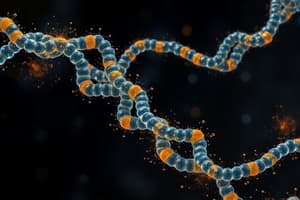Podcast
Questions and Answers
What is the primary function of nucleic acids in a cell?
What is the primary function of nucleic acids in a cell?
- To maintain the cell's structure
- To provide energy for the cell
- To synthesize proteins
- To carry genetic information and instructions for the functioning of the cell (correct)
What is the role of nucleic acids in heredity?
What is the role of nucleic acids in heredity?
- To transmit genetic information from one generation to the next (correct)
- To provide energy for the cell
- To maintain the cell's structure
- To synthesize proteins
What are nucleic acids composed of?
What are nucleic acids composed of?
- Nucleotides (correct)
- Carbohydrates
- Lipids
- Amino acids
What is the significance of nucleic acids in the continuity of life?
What is the significance of nucleic acids in the continuity of life?
What is the relationship between nucleic acids and proteins?
What is the relationship between nucleic acids and proteins?
Where is DNA typically found in prokaryotes?
Where is DNA typically found in prokaryotes?
What is the function of messenger RNA (mRNA)?
What is the function of messenger RNA (mRNA)?
What are the three primary components of a nucleotide?
What are the three primary components of a nucleotide?
What is the result of heating a DNA solution?
What is the result of heating a DNA solution?
What is the term for a compound consisting of a nitrogenous base and a sugar molecule?
What is the term for a compound consisting of a nitrogenous base and a sugar molecule?
What is the bond that forms between a sugar and a nitrogenous base in a nucleoside?
What is the bond that forms between a sugar and a nitrogenous base in a nucleoside?
What is the name of the nucleoside composed of adenine and ribose?
What is the name of the nucleoside composed of adenine and ribose?
What is the name of the nucleotide composed of adenine, ribose, and three phosphate groups?
What is the name of the nucleotide composed of adenine, ribose, and three phosphate groups?
What happens to the helical structure of DNA as the temperature increases?
What happens to the helical structure of DNA as the temperature increases?
What is the melting curve of DNA used to measure?
What is the melting curve of DNA used to measure?
What is the basis of measuring DNA denaturation using a spectrophotometer?
What is the basis of measuring DNA denaturation using a spectrophotometer?
Why does double-stranded DNA absorb less light at 260 nm compared to single-stranded DNA?
Why does double-stranded DNA absorb less light at 260 nm compared to single-stranded DNA?
What is the role of mRNA in protein synthesis?
What is the role of mRNA in protein synthesis?
What is the function of transfer RNA (tRNA) in protein synthesis?
What is the function of transfer RNA (tRNA) in protein synthesis?
What is the relationship between the absorbance of a DNA solution and the temperature?
What is the relationship between the absorbance of a DNA solution and the temperature?
What is the shape of the curve obtained by plotting the absorbance values with increase in temperature?
What is the shape of the curve obtained by plotting the absorbance values with increase in temperature?
Flashcards are hidden until you start studying
Study Notes
Nucleic Acids
- Nucleic acids are macromolecules composed of nucleotides as monomers.
- They are crucial for the continuity of life, carrying genetic information and instructions for cellular functioning.
- Nucleic acids serve as blueprints for protein synthesis in cells.
- They are the hereditary material in cells, responsible for passing genetic information from reproducing cells to their offspring.
DNA and Nucleic Acids
- DNA is the genetic material found in all living organisms, located in the nucleus of eukaryotes and in chloroplasts and mitochondria, and is not enclosed in a nucleus in prokaryotes.
Structure of Nucleic Acids
- A nucleotide is the building block of nucleic acids, consisting of a nitrogenous base, a sugar molecule, and one or more phosphate groups.
- A nucleoside is a compound consisting of a nitrogenous base and a sugar molecule, lacking the phosphate group(s).
- Nucleotides are named based on the nitrogenous base (e.g., Adenylic acid) or the number of phosphate groups (e.g., Adenosine monophosphate (AMP), Adenosine diphosphate (ADP), or Adenosine triphosphate (ATP)).
- Nucleosides are named based on the nitrogenous base (e.g., Adenosine, Guanosine, Thymidine, Cytidine, Uridine).
Denaturation of DNA
- Denaturation of DNA is the loss of helical structure of DNA as the temperature increases, resulting in the separation of DNA strands.
- Denaturation of DNA is measured using a spectrophotometer, based on the fact that nucleotide bases absorb light in the ultraviolet (UV) range.
- The melting curve of DNA is obtained by plotting the absorbance values with increasing temperature.
RNA
- RNA (ribonucleic acid) is involved in protein synthesis.
- Types of RNA include messenger RNA (mRNA), transfer RNA (tRNA), ribosomal RNA (rRNA), and microRNA.
- mRNA carries protein information from the DNA in a cell's nucleus to the cell's cytoplasm, where the protein-making machinery reads the mRNA sequence.
- tRNA acts as a temporary carrier of amino acids, bringing the appropriate amino acids to the ribosome based on the mRNA nucleotide sequence.
Studying That Suits You
Use AI to generate personalized quizzes and flashcards to suit your learning preferences.

![Molecular Biology: Nucleic Acids Structure [BIO 206]](https://images.unsplash.com/photo-1575468130766-fce03f7afaab?crop=entropy&cs=srgb&fm=jpg&ixid=M3w0MjA4MDF8MHwxfHNlYXJjaHwxMnx8TW9sZWN1bGFyJTIwQmlvbG9neSUyMENlbGwlMjBCaW9sb2d5JTIwTnVjbGVpYyUyMEFjaWRzJTIwQmlvc2NpZW5jZXN8ZW58MXwwfHx8MTcwMzkyNTEyNHww&ixlib=rb-4.0.3&q=85&w=300&fit=crop&h=200&q=75&fm=webp)


